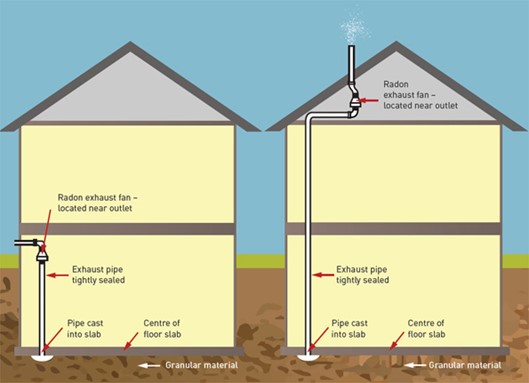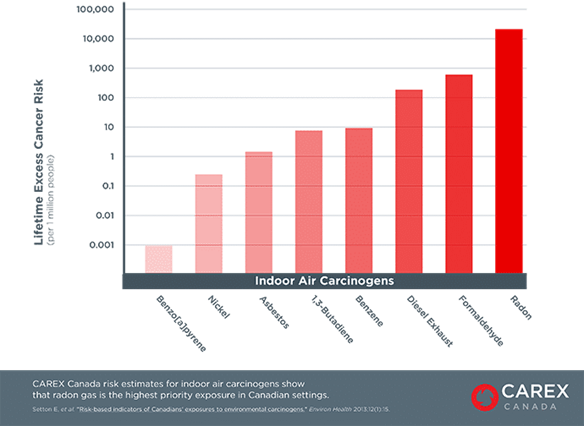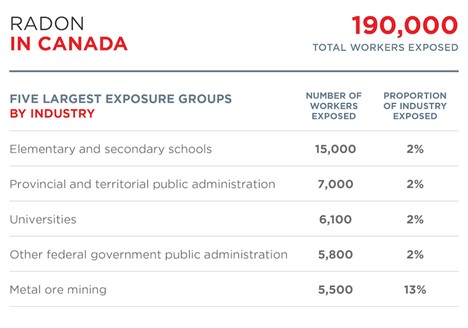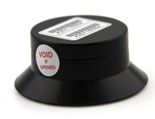We will be discussing why radon testing is needed in our schools and universities, how to test these buildings for radon and steps to take if high levels are found.
Why Radon Testing is Important
With increased radon testing being completed in British Columbia, the extent of the radon problem in our province is becoming clearer. The need for radon testing in schools and universities is abundantly evident. In many Interior BC Communities, greater than 30% of the residences tested exceed the Health Canada Radon Guideline of 200 Bq/m3. The BC Centre for Disease Control Interactive Map is a valuable resource that compiles radon testing data and shows recorded radon levels for regions and municipalities across the province.
Radon is the leading cause of lung cancer in non-smokers. It is responsible for more deaths in Canada each year than car accidents, carbon monoxide poisoning, and house fires combined.
According to CAREX Canada, a multi-institution research team hosted at the University of British Columbia, risk estimates for indoor air carcinogens show that radon gas is the highest priority exposure in Canadian environmental settings. The lifetime excess cancer risk is more than 10,000 times greater for radon than asbestos.
Over the past few years there has been a significant push to improve awareness for the need to test radon in our homes. However, to reduce overall lifetime exposure, there needs to be a focus on other places where people spend significant amounts of time, such as our workplaces and schools. According to CAREX Canada, around 190,000 Canadian workers are exposed to radon levels above Health Canada’s guideline of 200 Bq/m3. The industries with the highest rates of workplace exposure include elementary and secondary schools, provincial and territorial public administration, and universities. It’s worth noting that these figures include workers only and do not take into account the exposure of students or visitors to these locations.
In schools and universities, the number of students far exceeds the number of staff, making these buildings an even higher priority for radon testing. In addition, radiation exposure from radon while we are young can have increased harmful health effects. This makes it even more important to take action to minimize radon exposure in infants, children and youth. The Evict Radon website describes why young people are more vulnerable to radon gas exposure:
- Children have still-developing organs. Rapidly growing tissues and cells are very vulnerable to DNA damage from radiation exposure, as their DNA is being replicated. Any resulting genetic mutations can be propagated to all cells arising from the damaged cell.
- Children weigh less, and so their overall exposure (i.e. the amount of radon they absorb per kilogram of body mass) is much greater compared to an adult.
- Children breathe faster. An infant or small child will respire 2-3 times faster than adults as they have little lungs and are often more active. Faster breathing means more radon exposure.
- Children have more life left. Radon exposure causes DNA damage and genetic mutations that may take 10-30 years before lung cancer is diagnosed. Early life radon exposure means a person is more likely to live long enough to get cancer from it.
In terms of lifetime relative risk of developing lung cancer, a child exposed to 1,000 Bq/m3 radon from birth to their 6th birthday (5 years) has already inhaled the equivalent of a lifetime breathing in air with 200 Bq/m3 radon.
Radon Testing in Schools and Universities
The only way to know if a building has a high radon level is to test. Radon is invisible, odourless, tasteless and leaves no trace. Concentrations observed are specific to each building and specific areas of a building. It has been observed, over several instances, where one building has radon levels 20-30 times greater than the Health Canada Guideline while neighbouring buildings are well below the guideline. In schools, universities, and other public buildings, radon levels can vary significantly from building to building, section to section, and even room to room.

It is recommended to test all rooms that are occupied for 4 or more hours each day that have direct contact with the ground or a crawlspace. On upper levels, occupied rooms should be included in the testing if a room directly below it is not being tested.
Radon levels can change significantly over time and vary daily and seasonally, within a building. It is not unusual for radon levels to fluctuate by a factor of 2 to 3 over the course of a day, and variations between seasons can be even greater. Health Canada recommends a minimum three-month long-term measurement during the winter heating season when doors and windows are predominantly closed and there is a lower likelihood for outside air to dilute the indoor gasses. It is best to avoid carrying out long-term measurements during spring and fall if increased ventilation volumes are used as low-cost cooling in the building (i.e., economizing) as this can skew the results.
Health Canada recommends a C-NRPP Measurement Professional be involved in the measurement strategy and implementation of radon testing. More information on radon test placement and quality assurance measures can be found in Health Canada’s Guide for Radon Measurements in Public Buildings.
Alpha track devices are the most common technique for radon measurement. They are comprised of a small piece of bulletproof plastic enclosed in a plastic housing. The radiation from radon creates small scratches and pit marks in the bulletproof plastic. After a minimum of 90 days, it is sent to a lab for analysis. The device does not contain any harmful substances and is completely safe to be around children.
Buildings should be retested whenever major renovations are undertaken or there is an alteration of the ventilation or airflow within a building.
If the long-term radon test shows elevated radon levels, the first step is often to conduct short-term digital radon testing to determine if radon levels are elevated during occupied periods. Ventilation can help to lower radon levels during occupied periods, which reduces the radon exposure when people occupy the building. The average radon level measured on a long-term test may not be representative of the radon concentration when staff and students are present. Short-term radon testing completed with a digital continuous radon monitor can measure radon levels on an hourly basis. This allows the effect of the ventilation system to be determined, and the estimated long-term radon levels during occupied periods to be calculated.
Radon Mitigation in Schools and Universities
Radon concentrations can vary year-to-year and season-to-season. Health Canada recommends that mitigation still be considered when levels are below but approaching 200 Bq/m3. When long-term measurement results are over 600 Bq/m3, mitigations are recommended within the timeframe identified below based on the Guide for Radon Measurements in Public Buildings.
The two most common methods to lower radon levels in a school environment are increased ventilation, or the installation of an active soil depressurization radon mitigation system (ASD). An active soil depressurization system directly targets radon gas by minimizing the amount that enters the building. Ventilation dilutes radon by replacing some of the air in the space with low-radon outdoor air.
An active soil depressurization system works by creating a negative pressure zone beneath the building’s foundation or slab. This negative pressure pulls the radon gas into the radon piping system, discharges it to the atmosphere and prevents the radon from entering the building. To install a soil depressurization system, a hole (typically 5-7” in diameter) is cored through the foundation or slab, and a suction pit is created. A pipe with an inline fan is then installed so that it pulls air from the suction pit and vents it outside the building. The air and radon gas are then vented outside the building. Depending on the area of coverage needed, porosity of the sub slab material and building pressures, multiple suction points may be required for effective radon mitigation.

Sealing gaps and cracks in the foundation alone is typically not sufficient to reduce radon to acceptable levels. Because radon is pressure driven, even if all the visible cracks are sealed, there will be small entry points that allow radon gas to enter the building. However, for an ASD system to work effectively, the foundation must be well-sealed. The ASD system works by creating a pressure differential between the soil beneath the foundation and the indoor space. Cracks and gaps in the foundation reduce the pressure differential that can be achieved across the slab, resulting in the need for more suction points and higher-powered fans. With large gaps or numerous cracks, the system can’t achieve a sufficient pressure differential to reduce the radon gas infiltration into the building. If the foundation is a dirt crawlspace, it can be sealed with a poly membrane before an ASD is installed.
The following are key considerations when determining the most appropriate radon reduction method for a building:
- Radon levels
- Number and location of rooms with high radon levels
- Building design and foundation type
- Mechanical systems and ease of adding additional ventilation
- Relative pressures within the space
- Porosity of sub-slab material
- Installation cost
- Energy efficiency and operating cost
- Reliability
While both ventilation and ASD systems use energy to operate, an ASD system usually requires significantly less energy than a ventilation system. The increased ventilation flow rate required for effective lower radon levels in a space is typically much larger than the air moving through an ASD system. The majority of the cost associated with ventilation is energy required to heat or cool the outdoor air before it is introduced into the space.

A dedicated radon mitigation system, such as ASD, may be more reliable at reducing radon levels in the long term. A risk to using ventilation systems to control radon is how the ventilation control system can be altered relatively easily. There are examples of situations where staff, particularly new staff, who are not aware of the ventilation strategy objectives, lower the ventilation rates as a well-intentioned energy conservation measure. Ventilation can be used as an interim measure, reducing radon in the short term until the ASD system can be installed and commissioned.
Radon mitigation strategies should factor in installation costs as well as operating costs and reliability. Lowering radon levels in a building requires specific technical knowledge and skills. Health Canada recommends hiring a professional that is certified under the Canadian National Radon Proficiency Program (C-NRPP). Your radon mitigation team should also include individuals who are experienced with commercial buildings and have mechanical system and energy efficiency expertise.
Falcon Engineering is well known for its mechanical, electrical and energy engineering services. Did you know that we also specialize in radon mitigation? We have a mechanical engineer on staff who is a leader in the radon industry and is the only professional engineer who is also a registered C-NRPP Radon Mitigation Professional listed in BC. Along with our team of Mechanical and Energy Engineers, we are well suited to assist you with your radon needs. If you are interested in learning more about radon measurement and mitigation options for your facility, contact us and we can answer all your questions.
Want to learn more about our engineering services? Visit our integrated engineering services page.
Want to learn more about engineering? Check out some of our other blogs!




